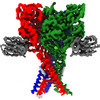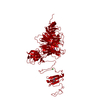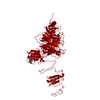+ Open data
Open data
- Basic information
Basic information
| Entry | Database: EMDB / ID: EMD-24580 | |||||||||
|---|---|---|---|---|---|---|---|---|---|---|
| Title | Human ASIC1a-Nb.C1 complex | |||||||||
 Map data Map data | ASIC1a-Nb.C1 complex | |||||||||
 Sample Sample |
| |||||||||
 Keywords Keywords | Channel Proton-gated Nanobody / MEMBRANE PROTEIN | |||||||||
| Function / homology |  Function and homology information Function and homology informationmonoatomic ion-gated channel activity / sensory perception of sour taste / pH-gated monoatomic ion channel activity / cellular response to pH / negative regulation of neurotransmitter secretion / response to acidic pH / neurotransmitter secretion / ligand-gated sodium channel activity / sodium ion transport / associative learning ...monoatomic ion-gated channel activity / sensory perception of sour taste / pH-gated monoatomic ion channel activity / cellular response to pH / negative regulation of neurotransmitter secretion / response to acidic pH / neurotransmitter secretion / ligand-gated sodium channel activity / sodium ion transport / associative learning / regulation of postsynapse assembly / behavioral fear response / sodium ion transmembrane transport / response to amphetamine / regulation of membrane potential / postsynaptic density membrane / calcium ion transmembrane transport / Stimuli-sensing channels / memory / presynapse / dendrite / glutamatergic synapse / cell surface / Golgi apparatus / plasma membrane Similarity search - Function | |||||||||
| Biological species |  Homo sapiens (human) / Homo sapiens (human) /  | |||||||||
| Method | single particle reconstruction / cryo EM / Resolution: 2.86 Å | |||||||||
 Authors Authors | Wu Y / Chen Z | |||||||||
| Funding support |  United States, 1 items United States, 1 items
| |||||||||
 Citation Citation |  Journal: Elife / Year: 2021 Journal: Elife / Year: 2021Title: Structure and analysis of nanobody binding to the human ASIC1a ion channel. Authors: Yangyu Wu / Zhuyuan Chen / Fred J Sigworth / Cecilia M Canessa /   Abstract: ASIC1a is a proton-gated sodium channel involved in modulation of pain, fear, addiction, and ischemia-induced neuronal injury. We report isolation and characterization of alpaca-derived nanobodies ...ASIC1a is a proton-gated sodium channel involved in modulation of pain, fear, addiction, and ischemia-induced neuronal injury. We report isolation and characterization of alpaca-derived nanobodies (Nbs) that specifically target human ASIC1a. Cryo-electron microscopy of the human ASIC1a channel at pH 7.4 in complex with one of these, Nb.C1, yielded a structure at 2.9 Å resolution. It is revealed that Nb.C1 binds to a site overlapping with that of the Texas coral snake toxin (MitTx1) and the black mamba venom Mambalgin-1; however, the Nb.C1-binding site does not overlap with that of the inhibitory tarantula toxin psalmotoxin-1 (PcTx1). Fusion of Nb.C1 with PcTx1 in a single polypeptide markedly enhances the potency of PcTx1, whereas competition of Nb.C1 and MitTx1 for binding reduces channel activation by the toxin. Thus, Nb.C1 is a molecular tool for biochemical and structural studies of hASIC1a; a potential antidote to the pain-inducing component of coral snake bite; and a candidate to potentiate PcTx1-mediated inhibition of hASIC1a in vivo for therapeutic applications. | |||||||||
| History |
|
- Structure visualization
Structure visualization
| Movie |
 Movie viewer Movie viewer |
|---|---|
| Structure viewer | EM map:  SurfView SurfView Molmil Molmil Jmol/JSmol Jmol/JSmol |
| Supplemental images |
- Downloads & links
Downloads & links
-EMDB archive
| Map data |  emd_24580.map.gz emd_24580.map.gz | 65.2 MB |  EMDB map data format EMDB map data format | |
|---|---|---|---|---|
| Header (meta data) |  emd-24580-v30.xml emd-24580-v30.xml emd-24580.xml emd-24580.xml | 15.9 KB 15.9 KB | Display Display |  EMDB header EMDB header |
| Images |  emd_24580.png emd_24580.png | 141.4 KB | ||
| Filedesc metadata |  emd-24580.cif.gz emd-24580.cif.gz | 6.3 KB | ||
| Archive directory |  http://ftp.pdbj.org/pub/emdb/structures/EMD-24580 http://ftp.pdbj.org/pub/emdb/structures/EMD-24580 ftp://ftp.pdbj.org/pub/emdb/structures/EMD-24580 ftp://ftp.pdbj.org/pub/emdb/structures/EMD-24580 | HTTPS FTP |
-Validation report
| Summary document |  emd_24580_validation.pdf.gz emd_24580_validation.pdf.gz | 390.3 KB | Display |  EMDB validaton report EMDB validaton report |
|---|---|---|---|---|
| Full document |  emd_24580_full_validation.pdf.gz emd_24580_full_validation.pdf.gz | 389.9 KB | Display | |
| Data in XML |  emd_24580_validation.xml.gz emd_24580_validation.xml.gz | 6.3 KB | Display | |
| Data in CIF |  emd_24580_validation.cif.gz emd_24580_validation.cif.gz | 7.2 KB | Display | |
| Arichive directory |  https://ftp.pdbj.org/pub/emdb/validation_reports/EMD-24580 https://ftp.pdbj.org/pub/emdb/validation_reports/EMD-24580 ftp://ftp.pdbj.org/pub/emdb/validation_reports/EMD-24580 ftp://ftp.pdbj.org/pub/emdb/validation_reports/EMD-24580 | HTTPS FTP |
-Related structure data
| Related structure data |  7rnnMC M: atomic model generated by this map C: citing same article ( |
|---|---|
| Similar structure data |
- Links
Links
| EMDB pages |  EMDB (EBI/PDBe) / EMDB (EBI/PDBe) /  EMDataResource EMDataResource |
|---|
- Map
Map
| File |  Download / File: emd_24580.map.gz / Format: CCP4 / Size: 103 MB / Type: IMAGE STORED AS FLOATING POINT NUMBER (4 BYTES) Download / File: emd_24580.map.gz / Format: CCP4 / Size: 103 MB / Type: IMAGE STORED AS FLOATING POINT NUMBER (4 BYTES) | ||||||||||||||||||||||||||||||||||||||||||||||||||||||||||||||||||||
|---|---|---|---|---|---|---|---|---|---|---|---|---|---|---|---|---|---|---|---|---|---|---|---|---|---|---|---|---|---|---|---|---|---|---|---|---|---|---|---|---|---|---|---|---|---|---|---|---|---|---|---|---|---|---|---|---|---|---|---|---|---|---|---|---|---|---|---|---|---|
| Annotation | ASIC1a-Nb.C1 complex | ||||||||||||||||||||||||||||||||||||||||||||||||||||||||||||||||||||
| Projections & slices | Image control
Images are generated by Spider. | ||||||||||||||||||||||||||||||||||||||||||||||||||||||||||||||||||||
| Voxel size | X=Y=Z: 0.83 Å | ||||||||||||||||||||||||||||||||||||||||||||||||||||||||||||||||||||
| Density |
| ||||||||||||||||||||||||||||||||||||||||||||||||||||||||||||||||||||
| Symmetry | Space group: 1 | ||||||||||||||||||||||||||||||||||||||||||||||||||||||||||||||||||||
| Details | EMDB XML:
CCP4 map header:
| ||||||||||||||||||||||||||||||||||||||||||||||||||||||||||||||||||||
-Supplemental data
- Sample components
Sample components
-Entire : Human ASIC1a in complex with Nb.C1
| Entire | Name: Human ASIC1a in complex with Nb.C1 |
|---|---|
| Components |
|
-Supramolecule #1: Human ASIC1a in complex with Nb.C1
| Supramolecule | Name: Human ASIC1a in complex with Nb.C1 / type: complex / ID: 1 / Parent: 0 / Macromolecule list: #1-#2 |
|---|---|
| Source (natural) | Organism:  Homo sapiens (human) Homo sapiens (human) |
-Macromolecule #1: Nanobodies Nb.C1
| Macromolecule | Name: Nanobodies Nb.C1 / type: protein_or_peptide / ID: 1 / Number of copies: 1 / Enantiomer: LEVO |
|---|---|
| Source (natural) | Organism:  |
| Molecular weight | Theoretical: 12.76221 KDa |
| Recombinant expression | Organism:  |
| Sequence | String: QVQLVESGGG LVQPRGSLRL SCAASGFTFS RAAMSWYRQA PGKEREMVST IGSFGVSTNY SDSVKGRFTI SRDNAKNTVY LHMNSLKPE DTAVYYCNAR YRSSYPWGQG TQVTVSS |
-Macromolecule #2: Acid-sensing ion channel 1
| Macromolecule | Name: Acid-sensing ion channel 1 / type: protein_or_peptide / ID: 2 / Number of copies: 1 / Enantiomer: LEVO |
|---|---|
| Source (natural) | Organism:  Homo sapiens (human) Homo sapiens (human) |
| Molecular weight | Theoretical: 60.001309 KDa |
| Recombinant expression | Organism:  Homo sapiens (human) Homo sapiens (human) |
| Sequence | String: MELKAEEEEV GGVQPVSIQA FASSSTLHGL AHIFSYERLS LKRALWALCF LGSLAVLLCV CTERVQYYFH YHHVTKLDEV AASQLTFPA VTFCNLNEFR FSQVSKNDLY HAGELLALLN NRYEIPDTQM ADEKQLEILQ DKANFRSFKP KPFNMREFYD R AGHDIRDM ...String: MELKAEEEEV GGVQPVSIQA FASSSTLHGL AHIFSYERLS LKRALWALCF LGSLAVLLCV CTERVQYYFH YHHVTKLDEV AASQLTFPA VTFCNLNEFR FSQVSKNDLY HAGELLALLN NRYEIPDTQM ADEKQLEILQ DKANFRSFKP KPFNMREFYD R AGHDIRDM LLSCHFRGEV CSAEDFKVVF TRYGKCYTFN SGRDGRPRLK TMKGGTGNGL EIMLDIQQDE YLPVWGETDE TS FEAGIKV QIHSQDEPPF IDQLGFGVAP GFQTFVACQE QRLIYLPPPW GTCKAVTMDS DLDFFDSYSI TACRIDCETR YLV ENCNCR MVHMPGDAPY CTPEQYKECA DPALDFLVEK DQEYCVCEMP CNLTRYGKEL SMVKIPSKAS AKYLAKKYNK SEQY IGENI LVLDIFFEVL NYETIEQKKA YEIAGLLGDI GGQMGLFIGA SILTVLELFD YAYEVIKHKL CRRGKCQKEA KRSSA DKGV ALSLDDVKRH NPCEGLRGHP AGMTYAANIL PHHPARGTFE DFTC UniProtKB: Acid-sensing ion channel 1 |
-Macromolecule #3: 2-acetamido-2-deoxy-beta-D-glucopyranose
| Macromolecule | Name: 2-acetamido-2-deoxy-beta-D-glucopyranose / type: ligand / ID: 3 / Number of copies: 2 / Formula: NAG |
|---|---|
| Molecular weight | Theoretical: 221.208 Da |
| Chemical component information |  ChemComp-NAG: |
-Experimental details
-Structure determination
| Method | cryo EM |
|---|---|
 Processing Processing | single particle reconstruction |
| Aggregation state | particle |
- Sample preparation
Sample preparation
| Concentration | 3.8 mg/mL | |||||||||||||||
|---|---|---|---|---|---|---|---|---|---|---|---|---|---|---|---|---|
| Buffer | pH: 7.4 Component:
Details: Solutions were filtered with 0.22um to avoid contamination. | |||||||||||||||
| Grid | Model: Quantifoil R1.2/1.3 / Material: GOLD / Mesh: 300 / Pretreatment - Type: GLOW DISCHARGE / Pretreatment - Time: 60 sec. / Pretreatment - Atmosphere: OTHER | |||||||||||||||
| Vitrification | Cryogen name: ETHANE / Chamber humidity: 100 % / Chamber temperature: 298 K / Instrument: FEI VITROBOT MARK III / Details: blot for 3s before plunging. | |||||||||||||||
| Details | This sample was monodisperse. |
- Electron microscopy
Electron microscopy
| Microscope | FEI TITAN KRIOS |
|---|---|
| Details | Preliminary grid screening was performed manually |
| Image recording | Film or detector model: GATAN K3 (6k x 4k) / Number grids imaged: 2 / Number real images: 7318 / Average exposure time: 1.4 sec. / Average electron dose: 45.0 e/Å2 |
| Electron beam | Acceleration voltage: 300 kV / Electron source:  FIELD EMISSION GUN FIELD EMISSION GUN |
| Electron optics | C2 aperture diameter: 100.0 µm / Illumination mode: FLOOD BEAM / Imaging mode: BRIGHT FIELD / Cs: 2.7 mm / Nominal defocus max: 2.0 µm / Nominal defocus min: 1.0 µm / Nominal magnification: 105000 |
| Sample stage | Specimen holder model: FEI TITAN KRIOS AUTOGRID HOLDER / Cooling holder cryogen: NITROGEN |
| Experimental equipment |  Model: Titan Krios / Image courtesy: FEI Company |
+ Image processing
Image processing
-Atomic model buiding 1
| Initial model |
| ||||||
|---|---|---|---|---|---|---|---|
| Refinement | Space: REAL / Protocol: RIGID BODY FIT / Overall B value: 200 / Target criteria: Correlation coefficient | ||||||
| Output model |  PDB-7rnn: |
 Movie
Movie Controller
Controller












 Z (Sec.)
Z (Sec.) Y (Row.)
Y (Row.) X (Col.)
X (Col.)























